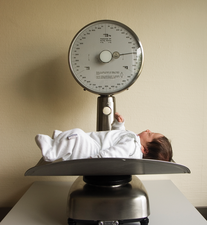Track your weight with a CGI script and Go
Programming Snapshot – Go CGI Scripting

© Lead Image © mathias the dread, photocase.com
Mike Schilli steps on the scale every week and records his weight fluctuations as a time series. To help monitor his progress, he writes a CGI script in Go that stores the data and draws visually appealing charts.
Capturing datapoints, adding them to a time series, and showing values over time graphically is usually the domain of tools like Prometheus. The tool retrieves the status of monitored systems at regular intervals and stores the data as a time series. If outliers occur, the messenger of the gods alerts its human to the fact. Viewing tools such as Grafana display the collected time series in dashboards spread over the last week or year as graphs, if so desired, so that even senior managers can see at a glance what's going on in the trenches.
However, my el cheapo web host won't let me install arbitrary software packages for this purpose on my rented virtual server. Plus, maintaining such complicated products with their continuous updates would be too time consuming for me, anyway. However, there is a '90s-style CGI interface on the web server. How hard could it be to write a CGI program in Go that receives measured values via HTTPS like an API, formats the time series generated from them into an attractive chart, and sends the results back to the browser in PNG format? Let's find out.
Figure 1 shows the graph of a time series that outputs my weight in kilograms over the past few years (possibly embellished for this article) as a chart in the browser after pointing it to the URL on the server. The same CGI script also accepts new incoming data. For example, if my scale shows 82.5 kilograms one day, calling
[...]
Buy this article as PDF
(incl. VAT)
Buy Linux Magazine
Subscribe to our Linux Newsletters
Find Linux and Open Source Jobs
Subscribe to our ADMIN Newsletters
Support Our Work
Linux Magazine content is made possible with support from readers like you. Please consider contributing when you’ve found an article to be beneficial.

News
-
AUR Repository Still Under DDoS Attack
Arch User Repository continues to be under a DDoS attack that has been going on for two weeks.
-
RingReaper Malware Poses Danger to Linux Systems
A new kind of malware exploits modern Linux kernels for I/O operations.
-
Happy Birthday, Linux
On August 25, Linux officially turns 34.
-
VirtualBox 7.2 Has Arrived
With early support for Linux kernel 6.17 and other new additions, VirtualBox 7.2 is a must-update for users.
-
Linux Mint 22.2 Beta Available for Testing
Some interesting new additions and improvements are coming to Linux Mint. Check out the Linux Mint 22.2 Beta to give it a test run.
-
Debian 13.0 Officially Released
After two years of development, the latest iteration of Debian is now available with plenty of under-the-hood improvements.
-
Upcoming Changes for MXLinux
MXLinux 25 has plenty in store to please all types of users.
-
A New Linux AI Assistant in Town
Newelle, a Linux AI assistant, works with different LLMs and includes document parsing and profiles.
-
Linux Kernel 6.16 Released with Minor Fixes
The latest Linux kernel doesn't really include any big-ticket features, just a lot of lines of code.
-
EU Sovereign Tech Fund Gains Traction
OpenForum Europe recently released a report regarding a sovereign tech fund with backing from several significant entities.

